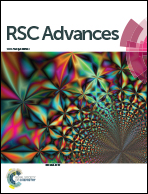Complicated synergistic effects between metal–π interaction and halogen bonding involving MCCX†
Abstract
The ternary systems FCCF⋯MCCX⋯NCH (M = Cu, Ag, Au, and Li; X = Cl, Br, and I) involving metal–π interaction and halogen bonding have been studied by quantum chemical calculations at the MP2/aug-cc-pVTZ level of theory as well as the corresponding binary ones. The halogen substituent has a slight effect on the strength of the metal–π interaction FCCF⋯MCCX, while the metal substitution has a prominent effect on the strength of the halogen bond MCCX⋯NCH. In the ternary systems involving LiCCX, both Li–π interaction and halogen bonding are simultaneously weakened compared to those in the dyads. Interestingly, the coinage-metal–π interaction and halogen bond are simultaneously strengthened in the ternary systems involving AgCCX. In the triads FCCF⋯CuCCX⋯NCH and FCCF⋯AuCCCl⋯NCH, the coinage-metal–π interaction is weakened but the halogen bond is strengthened. However, a reverse change is found for both interactions in the ternary systems involving AuCCBr and AuCCI. In general, due to the introduction of the second pertinent interaction, the halogen bond suffers a greater change in strength than the coinage-metal–π interaction.


 Please wait while we load your content...
Please wait while we load your content...